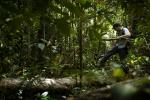Anchukaitis, Kevin
My primary research interests are the development of improved, quantitative, and objective estimates of past climatic and ecological variability and change, and the use of paleoenvironmental reconstructions to identify natural and anthropogenic influences on the ocean, atmosphere, and biosphere. My focus is primarily on the climate of the 'Common Era' -- the last two thousand years. In concert with the output of general circulation and regional models of the climate system, I am interested in using such reconstructions to better understand climate dynamics and the influence of changes in radiative forcing (solar, volcanic, and greenhouse gases) on global and regional climate at interannual to millennial time scales. Information about the long-term and low-frequency behavior of the climate system, as well as its response to perturbations and its potential range of natural and stochastic variability, are necessary for projecting the future response of the climate system to anthropogenic forcing. Paleoenvironmental reconstructions provide critical information about the response of both natural and human-altered environments to changes in the climate regime across a range of time scales. Paleoenvironmental reconstructions also provide insight into the interaction between human history and climate variability and change.
My research therefore encompasses three interconnected areas. First, I collect, develop, and calibrate new proxy paleoenvironmental data. My primary focus is the development of new tree-ring chronologies, particularly in the tropics, but also in North America, Asia, and the Mediterranean Rim. Second, I use new and existing proxy data from tree-rings and corals to develop paleoenvironmental reconstructions. This includes robust regional field reconstructions of both terrestrial (drought, precipitation, temperature) and marine (sea surface temperatures) climate. Finally, and perhaps most critically, such reconstructions are used in concert with physical and biological models in order to interpret the cause of past climate variability and ecological change and to develop an improved understanding of the Earth's dynamic climate system. The tools I use for this include mechanistic models of the relationship between proxies and climate variability (including tree-ring formation and stable isotope systematics), and simulations from general circulation and regional climate models.







